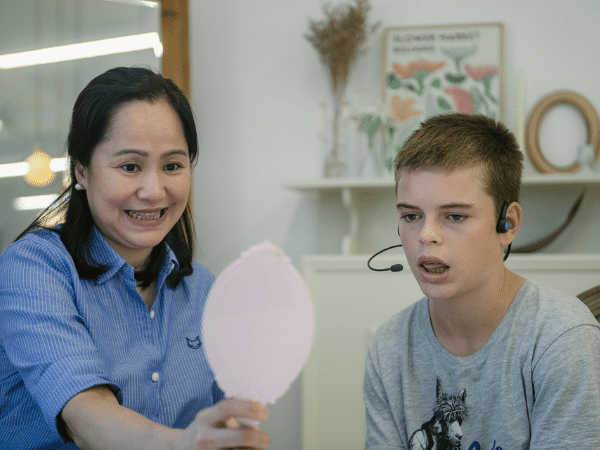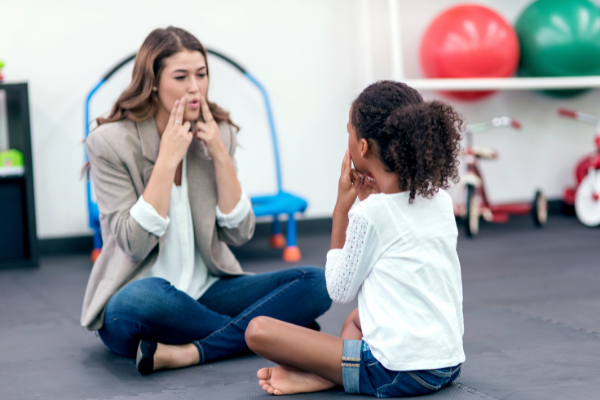for all of us to navigate.
Despite our best intentions, there are a number of unforeseen negative impacts that we are only just beginning to discover.
Of course, these impacts will vary from country to country, depending on how badly different areas were hit by the pandemic, but it is fair to say that most countries have prolonged periods of mandatory confinement where people were asked to stay home, where children were unable to attend school, and where it was forbidden to socialize with people outside of your household. Even once the height of the pandemic had passed and schools opened back up, teachers, and sometimes students were obliged to wear masks and socialization was still kept to a minimum.
We know that from birth to about 5 years of age is a critical window for developing communication skills: children begin to understand language, speak, and develop play and social skills. Children in this age bracket who have lived through the pandemic have been at a disadvantage when it comes to the opportunities available to develop these skills.
As a Speech & Language Therapist working with children aged 2-5, I have seen an unexpected surge in my caseload in the past 18 months. I’m based in France, so this article is based on what I have seen in my private practice here, however, given the nature of the pandemic, I imagine that other speech & language therapists in other parts of the world are experiencing something similar.
What is the difference between speech and language?
Before we go any further, it is important to clarify the difference between speech and language. Speech is related to the way that we say things: our ability to articulate clearly. Language, on the other hand, is related to content and is separated into two categories: Receptive Language and Expressive Language. Receptive Language refers to what we’re able to understand, and Expressive Language, as the name suggests, is what we are able to express. Someone can have excellent speech skills but have poor language skills, and the opposite can also be true.
Observations
Since the pandemic I have seen an unusually large number of children who have fairly good receptive language skills, meaning that they understand language, but not great expressive language skills and very poor speech skills. These children are able to understand a lot more than they are able to express, and the things that they are able to express are often difficult to understand because of their very poor speech skills. This can lead to a lot of frustration and anxiety around communication in some children.
When we consider the context of the past two years, this makes sense. Children were at home with minimum contact with people outside of the home. Their parents were often working from home, and not necessarily available to interact with their children all day every day. Children probably spent more time in front of screens (as we all did during this time) which means they will have been listening to language, but without being able to interact with people they were not practicing using language or speech. Speech is a motor skill, and like any motor skill, it requires a lot of practice speaking to improve our speech. With fewer opportunities to interact with other people, children did not have the same amount of practice speaking compared to before the
pandemic.
Another incredibly important factor is the use of masks for teachers in schools. While this was a necessary precaution to minimize the spread of the pandemic and protect the health and safety of the teachers, it meant that children were not able to hear their teachers clearly and were unable to see how their teachers’ mouths were moving to produce speech. One last thing to consider is that it is often teachers who first notice that a child’s speech or language development is not typical, and recommend that parents seek out the advice of a
Speech & Language Therapist. With prolonged periods of staying at home, children were not seeing their teachers so it’s possible that speech & language delays and disorders were not identified as early as they might have otherwise been.
Intervention and Assessment
While it is very interesting to speculate as to the “why” of all of this, the more important thing right now is to think about the types of things that we can put in place to support these children appropriately.
If we have concerns about a child’s speech & language development, the first step is always to have an assessment carried out by a Speech & Language Therapist, as they are the only people able to diagnose a speech or language delay or disorder.

Once we have a clear idea of exactly what is going on with a child’s speech and language, it is time to begin therapy. Therapy should be done by a Speech & Language Therapist, however, carry-over practice at home is essential to how successful therapy will be.
Forbrain
One of the many tools that I use in my practice when I’m working with children with speech disorders is a tool called Forbrain. This tool is great because it is incredibly easy to use, and can also be used by parents at home during carry-over practice.
Forbrain is a wireless headset that allows us to hear our own speech in real-time, just slightly louder thanks to the use of a small microphone and bone conduction.
The reason I like to use Forbrain with children with speech disorders is that it can help children to hear their own speech clearer. The first step to being able to improve our speech is being able to self-monitor and hear when our speech doesn’t sound quite right. Forbrain makes this process easier just by the simple feature of increasing the volume of our own voice.
Tips and Suggestions to use Forbrain in Therapy
When I am using Forbrain in the clinic with a child, I will aim to keep it on for as long as the child is comfortable wearing it. This could be anywhere from 10 minutes to the entire session. When the child is practicing speech they can wear the Forbrain in the traditional sense with the microphone pointed towards their own mouth, and if we happen to do Auditory Discrimination tasks where the child is required to listen while I make different sounds, the child can wear the Forbrain with the microphone directed towards my mouth to make my voice louder for them.
For carry-over practice at home, I recommend small amounts of daily practice, even just 10 minutes per day of targeted speech practice wearing the Forbrain can have a very positive impact.
If a child’s issue is more to do with language than speech, then an important thing we can do at home is to create a rich language environment. Reading books with Forbrain together daily is one easy way of doing this. Organizing outings to different places is another great way of doing this as it creates the opportunity to be exposed to a lot of different vocabulary.
Playdates are another easy way of boosting a child’s communication skills. The simple fact of interacting with a peer creates the opportunity to develop social skills and play skills and also provides the opportunity to practice using speech & language.
If you are concerned about your child’s speech or language it is important to seek the advice of a Speech & Language Therapist, but also remember that there are a lot of things that you can do at home to support your child’s speech & language development.
Learn how you can use Forbrain here.

.png?width=1900&name=blog_banner%20(1).png)


